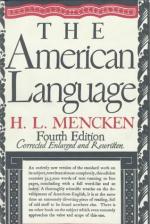
|
| Name: _________________________ | Period: ___________________ |
This test consists of 15 multiple choice questions and 5 short answer questions.
Multiple Choice Questions
1. In what sort of languages are double negatives "perfectly allowable"?
(a) Teutonic.
(b) Romance.
(c) Semitic.
(d) Asiatic.
2. In what year did the National Education Association withdraw from the campaign for simplified spelling?
(a) 1899.
(b) 1921.
(c) 1914.
(d) 1907.
3. How many works does Mencken claim to have discovered covering the topic of American slang?
(a) Three.
(b) Hundreds.
(c) One.
(d) Twelve.
4. Who published a work in 1768 entitled "Scheme for a New Alphabet and a Reformed Mode of Spelling, with Remarks and Examples Concerning the Same, and an Enquiry into its Uses"?
(a) Thomas Jefferson.
(b) Benjamin Franklin.
(c) Samuel Johnson.
(d) Noah Webster.
5. What sort of distinction frequently occurs between an adverb and its primary adjective?
(a) Syntactical.
(b) Pronunciation.
(c) Lexical.
(d) Numerical.
6. In what century did Americans begin to rebel against the capitalization trends dominant in England?
(a) The eighteenth.
(b) The seventeenth.
(c) The twentieth.
(d) The nineteenth.
7. According to Mencken, Italians often take the names of what nationality when they marry?
(a) French.
(b) German.
(c) Irish.
(d) English.
8. Who was responsible for the endowment to the Simplified Spelling Board?
(a) Andrew Carnegie.
(b) Noah Webster.
(c) Adrian Knox.
(d) Horace Hart.
9. How does Mencken characterize the vulgar American habitual use of the double negative?
(a) With "sturdy fidelity."
(b) With "unconscious loathing."
(c) With "happy fecundity."
(d) With "periodic intensity."
10. What is frequently omitted in phrases indicated desire or intent, as indicated in Chapter 9.9?
(a) Adjectival modifiers.
(b) Adverbial modifiers.
(c) The subject noun(s).
(d) Verbs of action.
11. Who was the author of the couplet that Mencken quotes: "For thou art a girl as much brighter than her / As he was a poet sublimer than me"?
(a) Matthew Arnold.
(b) Matthew Prior.
(c) Percy Bysse Shelley.
(d) John Keats.
12. What name is the Italian "Giuseppe" transformed into?
(a) Gregory.
(b) George.
(c) Jonathon.
(d) Joseph.
13. According to Mencken, the word "none" is a degenerate composition of what two words?
(a) No one.
(b) No tone.
(c) Not one.
(d) Not on.
14. Which of the following nations does Mencken not list as having more interesting war slang than the Americans during the Great War?
(a) Russia.
(b) England.
(c) France.
(d) Germany.
15. Which 1914 English dictionary made many important concessions to American spellings?
(a) The New English Dictionary.
(b) The Concise Oxford Dictionary.
(c) The London Pocket Dictionary.
(d) The Cambridge Fleet Edition.
Short Answer Questions
1. To what do English writers usually ascribe the American custom of numbering and lettering streets?
2. Which phrase did Oliver Wendell Holmes use to describe the state of the person who makes use of slang?
3. According to Dr. Louise Pound, what do Latin plurals tend to become in colloquial American?
4. Whose "gaping maw" often spoils an "apt and ingenious neologism," according to Mencken in Chapter 11.1?
5. From what newspaper does Mencken derive the story with which he opens Chapter 11.2?
|
This section contains 461 words (approx. 2 pages at 300 words per page) |

|




